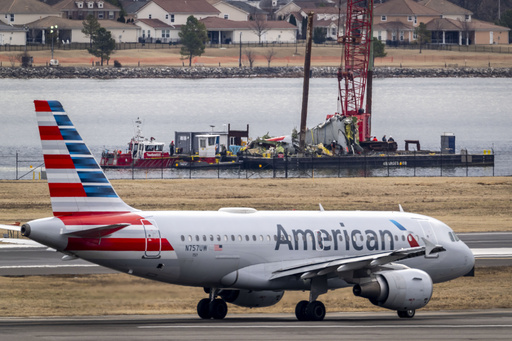
On January 29, a tragic incident occurred when an American Airlines passenger jet collided with a U.S. Army helicopter while the plane was attempting to land at Ronald Reagan National Airport in Washington D.C. Both aircraft fell into the Potomac River, resulting in the loss of all 67 individuals on board.
Investigators revealed on Friday that the helicopter likely experienced inaccurate altitude readings just prior to the crash, and further suggested that the crew may have missed critical communications from air traffic controllers.
This collision marks the deadliest aviation accident in the U.S. since 2001, when a plane crashed shortly after takeoff in a New York City neighborhood, claiming the lives of 260 individuals, along with five more on the ground.
Although air travel remains predominantly safe in the United States, there have been several recent incidents, including a fiery crash of a medical transport jet in a Philadelphia neighborhood on January 31 that resulted in seven fatalities. Additionally, a small commuter plane went down off the coast of western Alaska last week, leaving 10 people dead.
The American Airlines Flight 5342, which originated from Wichita, Kansas, was carrying 60 passengers and four crew members as it approached the airport for landing on a clear night. Simultaneously, a U.S. Army Black Hawk helicopter, with three soldiers on board, was executing a training mission, practicing evacuation routes intended for emergency situations involving transportation of essential government officials during crises.
Shortly before the jet was to touch down, air traffic controllers inquired if it could divert to a shorter runway, to which the pilots consented. Flight-tracking services indicated that the jet then modified its landing approach. Just before the collision, a controller was alerted that the two aircraft were on a convergence course and confirmed with the helicopter’s pilot whether they could see the approaching jet. The military pilot acknowledged this and requested visual separation, allowing them to fly closer to the jet than usual due to their line of sight. Controllers approved this request, but shortly after, the two aircraft collided.
In the aftermath of the collision, the National Transportation Safety Board (NTSB) has retrieved all flight data recorders and has extracted the wreckage from the river.
The final report by the NTSB might take over a year to complete; however, the agency is committed to providing consistent updates as the investigation proceeds and plans to publish a preliminary report soon.
NTSB Chairwoman Jennifer Homendy addressed reporters on Friday, indicating that the cockpit recorder from the Black Hawk revealed that a disrupted radio communication might have prevented the crew from hearing air traffic control instruct them to position themselves behind the jet just moments before the crash.
“That transmission was interrupted – it was stepped on,” she noted, clarifying that the crew did not hear the instruction to “pass behind the” due to simultaneous microphone engagement.
Investigators believe the collision likely took place at an altitude of approximately 325 feet, putting the Black Hawk above its designated limit of 200 feet for that area. Conversations from the cockpit leading up to the incident indicated potential issues with altitude readings; the helicopter’s pilot stated a height of 300 feet, while the instructor pilot claimed it was at 400 feet.
“We are exploring the possibility that there may be erroneous data,” Homendy added.
This particular series of Black Hawks is equipped with two types of altimeters: one operates based on barometric pressure, and the other uses radio frequency signals reflecting off the ground. Helicopter pilots generally rely on barometric readings, whereas the helicopter’s black box records its radio altitude readings.
Right after the incident, President Donald Trump publicly criticized the helicopter, which has a flight ceiling of 200 feet, for exceeding that altitude. He also attributed blame to federal diversity and inclusion policies concerning air traffic controllers. However, when pressed by reporters for evidence of his claims, the president could not substantiate his statements. Shortly thereafter, he redirected his criticism towards what he described as an “outdated” air traffic control system.
Army officials have affirmed that the crew operating the Black Hawk was seasoned and accustomed to managing the busy air traffic over Washington.
The Army has identified the Black Hawk crew members, including Captain Rebecca M. Lobach from Durham, North Carolina; Staff Sergeant Ryan Austin O’Hara, 28, from Lilburn, Georgia; and Chief Warrant Officer 2 Andrew Loyd Eaves, 39, from Great Mills, Maryland. O’Hara served as the crew chief, while Eaves and Lobach were pilots.
The airline passengers included members of the Skating Club of Boston, who were returning from a developmental camp for young elite skaters following the 2025 U.S. Figure Skating Championships held in Wichita. Other victims comprised hunters returning from a guided trip in Kansas, four members of a steamfitters’ local union from suburban Maryland, as well as nine students and parents from schools in Fairfax County, Virginia, along with two Chinese nationals.

